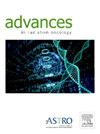前列腺癌每日两个相对场与每日一个交替场碳离子放射治疗生物有效剂量的估计差异
IF 2.7
Q3 ONCOLOGY
引用次数: 0
摘要
目的:本研究旨在确定每天两个相对场(2场/天)的前列腺癌碳离子放射治疗是否比每天一个交替场(1场/天)的方法在正常组织的生物有效剂量(BED)方面具有显著优势。方法与材料碳离子放射治疗的处方剂量为54 Gy(相对生物有效性[RBE]),分12个部分,随机选择10例患者进行分析。BED采用3种方法计算:线性二次模型,修正微剂量动力学模型(mMKM),固定临床RBE为2.41(大多数治疗计划系统采用),以及未重新缩放的mMKM,使用域半径(rd)值为0.28,0.38和0.45µm, α/β比为3,5和10 Gy。危险器官(OARs)按照标准指南进行轮廓。基于使用各种方法估计的床,比较了每天2场和每天1场方法之间的剂量学和剂量-体积直方图差异。采用Wilcoxon符号秩检验进行统计分析,P <; 0.05认为有统计学意义。结果:对于非中心位置的OARs,特别是股骨头、皮肤和骨髓,每天2场的方法显著降低了BED。其中,股骨头表现出最大的相对平均BED差异,线性二次模型(α/β= 3 Gy)约为17%,使用固定临床RBE的mMKM模型约为7%,mMKM模型约为9% (rd = 0.38µm, α/β= 3 Gy), P值均为<; 01。相比之下,闭孔肌和其他位于中心位置的桨,包括尿道、膀胱和直肠,观察到的差异很小,相对BED差异保持在3%以下。与每天1个油田的方法相比,每天2个油田的方法对非中心位置的桨叶的BED较低,尽管使用不同方法来估计BED之间存在显著差异。BED的减少需要进一步的研究来评估其临床意义和对毒性的影响。本文章由计算机程序翻译,如有差异,请以英文原文为准。
The Estimated Difference in Biologically Effective Dose Between Two-Opposing-Fields-Per-Day and One-Alternating-Field-Per-Day Carbon Ion Radiation Therapy for Prostate Cancer
Purpose
This study aims to determine whether two-opposing-fields-per-day (2-fields-per-day) carbon ion radiation therapy for prostate cancer provides a significant advantage in terms of biologically effective dose (BED) for normal tissue compared to the one-alternating-field-per-day (1-field-per-day) approach.
Methods and Materials
The prescribed dose for carbon ion radiation therapy is 54 Gy (relative biological effectiveness [RBE]) in 12 fractions, and 10 patients were randomly selected for analysis. BED was calculated using 3 methods: the linear-quadratic model, modified microdosimetric kinetic model (mMKM) with a fixed clinical RBE of 2.41 (adopted in most treatment planning systems), and the mMKM without rescaling, using domain radius () values of 0.28, 0.38, and 0.45 µm with ratios of 3, 5, and 10 Gy. Organs at risk (OARs) were contoured following standard guidelines. The dosimetric and dose-volume histogram differences, based on BEDs estimated using various methods, were compared between the 2-fields-per-day and 1-field-per-day approaches. Statistical analyses were performed using the Wilcoxon signed rank test with P < .05 considered statistically significant.
Results
The 2-fields-per-day approach resulted in significantly lower BED for noncentrally located OARs, particularly the femoral head, skin, and bone marrow. Among these, the femoral head showed the largest relative mean BED difference, with approximately 17% using the linear-quadratic model (= 3 Gy), 7% with the mMKM model using a fixed clinical RBE, and 9% with the mMKM model ( = 0.38 µm, = 3 Gy), with all P values <.01. In contrast, the differences observed for the obturator muscles and other centrally located OARs, including the urethra, bladder, and rectum, were minimal, with relative BED differences remaining below 3%.
Conclusions
Compared to the 1-field-per-day approach, the 2-fields-per-day approach results in lower BED for noncentrally located OARs, though significant variation is observed between the different methods used to estimate BED. The reduction in BED requires further investigation to evaluate its clinical significance and impact on toxicity.
求助全文
通过发布文献求助,成功后即可免费获取论文全文。
去求助
来源期刊

Advances in Radiation Oncology
Medicine-Radiology, Nuclear Medicine and Imaging
CiteScore
4.60
自引率
4.30%
发文量
208
审稿时长
98 days
期刊介绍:
The purpose of Advances is to provide information for clinicians who use radiation therapy by publishing: Clinical trial reports and reanalyses. Basic science original reports. Manuscripts examining health services research, comparative and cost effectiveness research, and systematic reviews. Case reports documenting unusual problems and solutions. High quality multi and single institutional series, as well as other novel retrospective hypothesis generating series. Timely critical reviews on important topics in radiation oncology, such as side effects. Articles reporting the natural history of disease and patterns of failure, particularly as they relate to treatment volume delineation. Articles on safety and quality in radiation therapy. Essays on clinical experience. Articles on practice transformation in radiation oncology, in particular: Aspects of health policy that may impact the future practice of radiation oncology. How information technology, such as data analytics and systems innovations, will change radiation oncology practice. Articles on imaging as they relate to radiation therapy treatment.
 求助内容:
求助内容: 应助结果提醒方式:
应助结果提醒方式:


